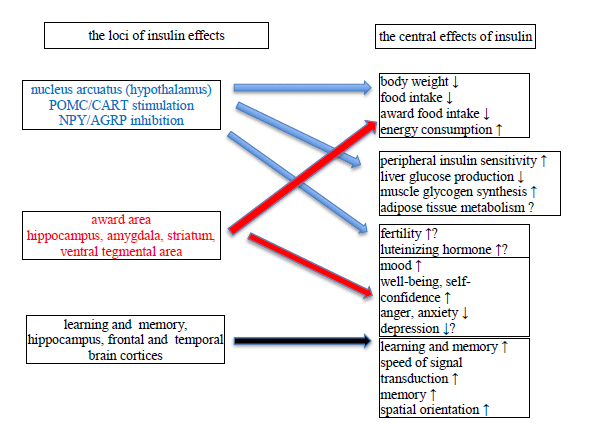III.5.B. The central effects of insulin
Besides their direct roles (regulation of the release of digestive enzymes and intestinal motility), various gastrointestinal hormones regulate the food intake. These hormones (GLP-1, CCK and PYY) are produced in the brain and indicate satiety signals. and they also regulate the amount of food intake.
Their main role is to inhibit overeating, i.e. the intake of a greater amount of food than the body can use.
The detection of Glu is performed in the periphery and in the brain.
In the central nervous system:
hypothalamus HT-VMH
brainstem-medulla oblongata nucleus tractus solitarius
limbic system amygdala
The peripheral Glu receptors:
vena portae
pancreas
small intestine
It has not been established that only a decrease of the Glu level is the food intake-stimulating signal on physiological fasting.
The brain Glu intake is regulated in an insulin-independent way. In the brain, the GLUT-1 and GLUT-3 transporters are insulin-independent. Insulin-related GLUT-4 and GLUT-8 transporters are also to be found in the brain. Insulin receptors are located found in various areas of the brain (bulbus olfactorius, cerebral cortex, hippocampus, hypothalamus, amygdala and glia). Insulin passes through the blood-brain barrier and participates in various regulatory mechanisms in the brain (Fig. 16).

Figure 16. The central effects of insulin
(POMC/ CART = proopiomelanocortin- and cocaine- and amphetamine- regulated transcript, NPY = neuropeptide Y, AGRP = Agouti-related peptide )
In relationship with the effects of memory, Alzheimer’s disease (AD) is more frequent in obese or T2DM patients. Insulin resistance develops in the periphery and in the brain. In the case of brain insulin resistance, the level of glycogen synthase kinase 3 β (GSK-3β) is increased by the decreased insulin receptor signal in the brain, which activates γ-secretase, the enzyme which produces amyloid-β peptide (Aβ) from the amyloid precursor protein (APP); this is responsible for the development of AD. Insulin-degrading enzyme (IDE) is inhibited by APP and Aβ (proinflammatory cytokines), which exacerbates insulin resistance. Several animal studies have demonstrated, that peripheral insulin sensitivity is influenced by brain insulin resistance, which may cause peripheral insulin resistance and therefore development of the MetS.